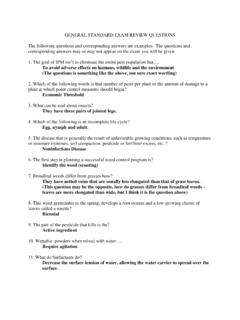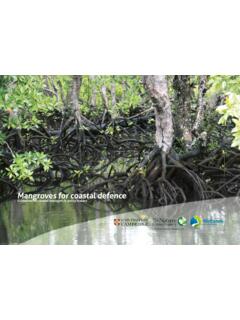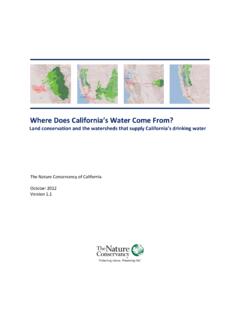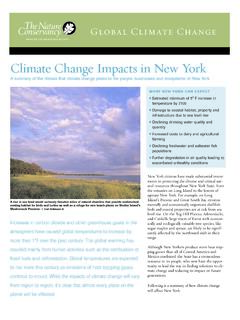Transcription of Rights of Way - APPLICATOR EXAM REVIEW QUESTIONS
1 Rights of Way - APPLICATOR EXAM REVIEW QUESTIONS . The following QUESTIONS and corresponding answers are examples. The QUESTIONS and corresponding answers may or may not appear on the exam you will be given. The actual test is only 50 QUESTIONS . REVIEW these QUESTIONS in addition to the General Standards Exam study guide. 1. Why are plant growth regulators used in right of ways? To maintain desired height of turf around guardrails. 2. What type of herbicide is used for total vegetation control (TVC) used around guardrails? Residual, nonselective herbicides. 3. What is girdling?
2 P 15. Cutting a grove or notch into the trunk of a tree to interrupt the flow of sap between roots and crown. Can be done by cutting a ring around a woody plant through the bark and sapwood (cambium). 4. What is grubbing? P 15. Uprooting plants by pulling or digging. 5. Why are growth regulators used instead of herbicide in some areas? P 15. They are used to slow vegetation growth in areas where brownouts from herbicides are unacceptable. Such as along steep slopes and cemeteries. 6. What growth regulators are used typically and why? P 15. Maleic hyrazide, mefluidide, and flurprimidal.
3 These compounds are used in areas where brownout from herbicides are unacceptable. 7. How do photosynthetic inhibitor herbicides work? P 17. They translocate in the xylem from the roots to the older leaves. 8. What are meristematic tissues? P 19. The growing points of plants. 9. Why are ACCase inhibitors ( lipid biosynthesis inhibitors used)? P 19. They selectively control grass but broadleaf plants are unaffected by them. 10. How are dinitroanilines used to control annual grasses and small-seeded broadleaf plants? P 19. They are soil applied 11. How do herbicide-resistant weeds develop?
4 P 20. Herbicide controls the majority of plants and only those that possess a resistant trait can survive and produce seed for future generations (natural selection). 12. What are the two mechanisms that allow plants to become herbicide resistant? P 20. The target site is somewhat altered and the herbicide molecule cannot exert toxin. The weed is able to metabolize the herbicide or make it inactive. 13. What is frilling? P 24. Series of downward angled cuts make completely around the tree, leaving partially severed bark and wood attached at the bottom. It is typically performed with a hatchet or axe.
5 14. What steps can be taken to minimize herbicide resistant weeds? P 21. a. Scout regularly to identify resistant weeds b. Rotate herbicides with different sites of action c. Apply herbicides with multiple sites of action d. Combine mechanical and non-chemical control practices e. Clean equipment before moving from infested areas with resistant weeds to non infested areas. f. All of the above 15. What is herbicidal activity? P 23. When a particular herbicide binds to a target site within the plant and exerts a lethal effect. 16. What are the different ways that herbicides can be applied to plants?
6 P 23. Onto leaves (foliar treatment) or onto stem or trunk (frill, girdle, basal-bark or cut- surface treatment. 17. What are the methods of killing standing trees without herbicide? P 24. Frilling and girdling. 18. How is basal bark treatments performed? P 25. Herbicide is sprayed on small trees and shrubs on the lower 12-18 inches of bark. It is most effective on trees smaller than 4-6 inches in diameter. 19. How are soil treatments (basal soil) herbicides used? P 27. They are applied within the dripline of target species so that herbicide can move by rainfall into the root zone.)
7 20. Why are soil treatment herbicides not used in many areas? P 27. They are quite persistent and mobile in water, so can they run off and leech into surface or underground water sources. 21. When is the greatest potential for spray drift? P 28. When wind velocity is greater than 10 miles an hour or when the wind is blowing toward sensitive plants or critical areas. 22. When should you not apply low volume sprays (those having smaller droplet size)? P 28. During periods of high temperature or low humidity. (since droplets evaporate easier). 23. When are cut stump applications of herbicide used?
8 They are used to control trees with thick barks or trunks greater than 5 inches in diameter. 24. How do you avoid the pressure decreasing as the liquid is sprayed from a compressed air sprayer? P 29. Fill the tank only 2/3 full with spray material and repressurize the tank frequently. 25. What are considerations for choosing equipment for right- of way applications? P 29. a) Size of area b) Target vegetation c) Terrain d) Pesticide formulation e) All of above 26. What are the benefits and drawbacks of piston pumps? P 30. They can provide higher spray pressure than diaphragm pumps but cannot be used with abrasive formulations.
9 27. How are the most effective injections of pesticides performed? P 31. a) At the base of the tree b) Not made into deep folds or creases of the root flare. c) Holes less than diameter made at a depth of to1 spaced every 3 to 6 inches around tree. d) Number of tree holes is determined by diameter of tree at breast height (DBH). e) All of the above 28. Injection equipment is used to put pesticide directly into the plant's? P 30. Living tissue 29. Injections can also be used to treat for? P 30. Treating insect pests and diseases 30. Boom sprayers provide? P. 31. Broadcast applications with the best uniformity.
10 31. What drawbacks do boomless sprayers have when they are used to make broadcast applications? P31. Uniformity is not as good as with a boom sprayer even when using off-center nozzles. 32. What are spray guns used for with high pressure sprayers? P 31. Spot application, high and low volume foliar application and for basal applications 33. Spray guns are not recommended for? P 32. Broadcast applications, since exact pressure, walking speed, arm motion and nozzle height/ angle must be maintained for uniformity. 34. Spray droplets smaller than _____ microns are at risk of drifting?









